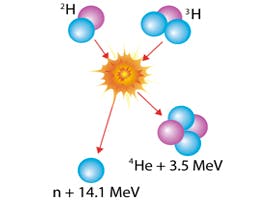
12 Apr 2022
Not Another Helium Crisis
By Tony Taylor
Here we go again - on the brink of yet another Helium crisis, the fourth since 2010! Reports abound in the industry press and suppliers are sending warning letters of supply chain issues, price rises and restrictions on order volumes. In contrast to the previous crisis in late 2019 and early 2020, the present situation has seen more suppliers limit allocation (sometimes between 45 and 65% of ‘typical’ use volumes) rather than increase prices, although naturally, the prices are creeping up as supply tightens.

As chromatographers, our thoughts turn to the use of hydrogen as an alternative carrier gas, to ensure continuity of supply and reduce long term costs. I’ve written two blog entries in the recent past [1,2] regarding the practical implementation of hydrogen carrier gas, and whilst it is a very convenient alternative to generate your own hydrogen carrier gas within the laboratory using only deionized water as a feedstock, there are drawbacks. Besides the initial purchase costs of the generator(s), due to the explosive nature of hydrogen in the air, there may be safety measures that need to be implemented to detect gas leakage. Methods need to be translated in order to match the retention and selectivity characteristics of the original helium-based method. When using Mass Spectrometric detection, there are minimum flow requirements to ensure pneumatic controllers are able to cope with low back pressure requirements, source components may need to be changed to ensure vacuum levels within the detector can be maintained and one needs to be mindful of the possibility of altered spectral ion ratios and possible hydrogenation reactions within the ion source, both of which can lead to altered qualitative and quantitative results.
Helium formed through underground radioactive of 238U decay is typically released into the atmosphere (and subsequently quickly lost into space) through permeable rock; however, where the rock is impermeable, the helium is trapped alongside natural gas deposits. Cryogenic high-pressure fractional distillation can be used to separate helium and nitrogen from methane and subsequently cooled in a condenser to separate the crude helium (which contains 50–70% helium, 1–3% residual methane, small quantities of hydrogen and neon, and the remaining balance is nitrogen). This crude helium is then cooled to -315 oF where the nitrogen and remaining methane condense and are drained off. Air is then added and warmed in the presence of a catalyst, causing hydrogen to react with oxygen from the air to form water vapour, which can be condensed through cooling and drawn off. A pressure swing adsorption (PSA) unit is then employed to separate high purity helium (99.99%) from any remaining impurities by selective removal using microporous adsorbents [3]. Where helium concentrations within the natural gas deposits are low (typically below 0.3% by volume), companies use more advanced, multi-bed PSA technology to recover the helium in an economically viable manner [4]. As the half-life of 238U is around 4.5 billion years (the earth is estimated to be around 4.7 billion years old), a vanishingly small amount of ‘new’ helium is produced each year and therefore it is afforded ‘non-renewable source’ status.
Helium is used by a variety of industries, including cryogenic cooling of Magnetic Resonance Imaging (MRI) instruments, as a lifting gas for airships and rockets, for welding, semi-conductor manufacture and as a leak detection vehicle, with scientific and analytical uses for helium accounting for approximately 20% of the annual helium consumption. The total global consumption of helium (2021) is estimated at approximately 176 million cubic meters [5] with the global resource estimated at 5.9 billion cubic meters [5], resulting in a total of 335 years of supply at current consumption levels.
What's Causing the Issue?
So, given that there are plentiful helium reserves, what are the causes of the current supply issues?
Global helium production by region is shown in Figure 1;

Figure 1: Global Helium Production by Geographical Region [7]
The US National (sometimes called Federal) Helium Program Reserve, currently administrated by the US Bureau of Land Management (BLM) is held at the Cliffside Storage Facility in a natural underground facility located in the Texas Panhandle, near the natural gas fields around Amarillo. Whilst some of the helium is refined in the local gas fields, much is piped over many hundreds of miles from other northern United States refining facilities. The Mineral Leasing Act of the 1920s reserved all helium production for US Government use, whilst the Helium Acts Amendment of 1960 allowed the US Bureau of Mines to arrange for five private plants to recover helium from natural gas, effectively a government purchase of the helium stockpile. By 1995, the National Helium Reserve contained 1 billion cubic meters of gas but was $1.4 billion dollars in debt and the Helium Privatization Act of 1996 mandated that the helium reserve should be sold off in order to pay down these debts. The hope was that by 2015 the reserve would have been sold off and that private industry would establish new sources of helium to satisfy demand. Critically, the pricing for the auctions of the reserve was set below market value in order to ensure that the debt was paid off quickly, keeping global pricing relatively low, however, ongoing costs of production and maintenance of the reserve have led to unpredictable price adjustments up to market levels, affecting the helium price globally.
The interest of private industry in helium production did match the 1996 expectations of the US Government, and in 2013 the Helium Stewardship Act was signed into law, allowing sales from the National Helium Reserve to continue to September 2021 (now September 2022), effectively ending federal involvement with the reserve. This act effectively slowed the sale of federal helium and allowed the Bureau of Land Management to auction the gas at higher prices. The bill prevented the federal government from undercutting private producers, thus encouraging more sources of helium production to go online.
The effective end of the public sale of helium from the BLM at Cliffside may herald future supply or pricing issues; however, in the shorter term, the facility has other problems. Following a four-month shutdown in late 2021, the facility has not returned to production due to the discovery of a major leak, leading to a reduction of 14 million cubic meters per annum in the global supply.
A new production plant in the Amur region of Russia was due to add a further 20 to 30% capacity (up to 70 million cubic meters) into global supply by 2023; however, a fire in October 2021 followed by an explosion and fire in January 2022 has resulted in zero capacity from this plant currently. There is no proposed date for the plant coming online, but I have seen estimates of 6 months upwards. Of course, the supply from the Amur facility is further compounded by Russia’s war with Ukraine, which has led to an embargo on oil and gas product imports.
The Arzew facility in Algeria usually produces helium as a result of the liquefaction of natural gas, which is transported globally by container ship. This compression/liquefaction process makes the production of helium economically viable at this facility because it liquefies at much higher pressures and lower temperatures than natural gas. Again, due to the war in Ukraine, European natural gas supplies are currently highly restricted and most of the natural gas from Arzew is being transported directly by pipeline into Europe via Spain. As transport by pipeline does not require liquefaction, then the extraction of helium is currently not economically viable, leading to a further reduction in global supply. It is estimated that globally, liquified natural gas production is down 30% from January this year, for similar reasons to those above, representing a reduction of 10% in total global supply.
These are just some of the contributors to the current supply chain issues. Others include an embargo of gas from Qatar passing through Saudi Arabia to a large port in the United Arab Emirates (although this situation is apparently now resolved) and various maintenance and unplanned outages from a range of smaller production facilities globally. This ‘perfect storm’ has resulted in the current supply chain issues, any one of which may have caused a ‘blip’ in helium availability, but collectively are presenting a very challenging supply situation. So, what of the short and mid-term future for helium supply.
Clearly, the BLS facility at Cliffside needs to come back online as soon as possible and I have seen reports for production starting again before June. However, the situations in the Amur and Azew facilities do not appear to have a short-term resolution, given the current, and likely ongoing, geopolitical situation.
What's The Outlook?
The medium to long term situation does look brighter. One large gas supplier recently announced the opening of the world’s largest helium storage cavern facility, again in Texas, with supply capacity planned to outstrip that of the BLM plant [8]. New companies are forming to extract helium as a ‘pure play’ resource, that is, mining and exploration for pure helium extraction rather than as a side product of natural gas refining. Sites are being developed in Saskatchewan, Utah and Tanzania which could contribute significant capacity to the system from 2024 onwards.
From current research, I believe the short-term supply issues will not resolve quickly, but that mid to long term there is enough commercial and political interest in maintaining a secure supply of helium for scientific and medical diagnostic use. As chromatographers we need to keep a keen eye on the helium supply chain and ensure we plan for shortages and price increases over the next two years, whereafter, hopefully, the supply chain issues will ease. All that being said – our facilities continue to investigate the suitability of alternative carrier gases, including nitrogen, for our range of applications.
References
- Using Hydrogen Carrier Gas with Mass Spectrometric Detection
- Is Hydrogen the Only Viable Gas Chromatography Carrier Gas for the Long-Term?
- https://phys.org/news/2010-08-world-helium-nobel-prize-winner.html
- https://phys.org/news/2010-08-world-helium-nobel-prize-winner.html
- United States Geological Survey, Mineral Commodity Summaries, 2019.
- United States Geological Survey, Mineral Commodity Summaries, 2019.
- https://www.maximizemarketresearch.com/market-report/global-helium-market/26772/
- https://www.gasworld.com/air-products-reveals-worlds-largest-helium-storage-cavern/2022545.article



